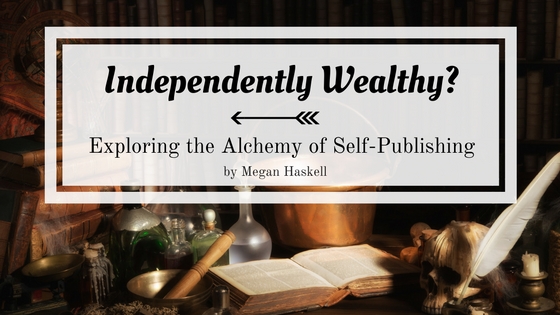by Megan Haskell
Fifteen years ago, if you said you were an independent author people would laugh you out of the room. Fact was, self-publishing was equivalent to vanity publishing; the only reason that a book was being printed was to satisfy the author’s personal ego.
Vanity Presses
Prior to 2010, self-publishing equalled failure. Independent authors were viewed as hacks who couldn’t cut it in “real publishing”. It was a rare author who could be successful without following the traditional path of agent –> publisher –> bookstore. And that made sense! Before the advent of the ebook, the cost to print and distribute paperback (or hardcover, if you were really lucky!) books was enormous. There was no way an indie could reach the same audience as the traditional publishers.
However, for the truly determined authors who wanted a book in hand, the vanity press was ready and willing to fulfill the print requirements. These were companies that would print a thousand copies of an author’s book for an up-front fee. There was no selection criteria or quality considerations for the job—they would print whatever you gave them—and the cost would reside somewhere in the realm of $5k-$10k.
Print On Demand (POD) Made Paperbacks Easy
In the mid-1990s, new technology arose that could print one book at a time at a very low cost. Self-published authors no longer needed to pay thousands of dollars for a print run that may or may not sell. Nor would they need to store the thousands of books printed in their garage or self-storage.
However, it was still challenging, if not impossible, to get independently published titles into physical bookstores. It wasn’t until the internet rose to power and books could be sold online that there was any real viability to the POD strategy.
Rise of the Kindle
However, with the rise of the internet, technology made publishing easier. You could publish your words online for free, but there was still a problem of readability (who wants to stare at a computer screen to read a book?) and market visibility (how do you get yourself noticed in a sea of plain jane websites?).
Then came the Kindle.
On November 19, 2007, Amazon released the first Kindle ereader, a device that allowed readers to easily read digital books on a small tablet that mimicked paper with its e-ink technology. You could store hundreds, even thousands of books on a machine that was smaller than a regular paperback. Even better for some genres, the lack of a book cover meant no one knew what you were reading!
The device sold out in five and a half hours. It took five months for Amazon to catch up with demand.
Kindle Direct Publishing
Suddenly, there was demand for cheap digital books. For obvious market reasons, Amazon was anxious to fill their new Kindle devices with as many books as readers could possibly hope to read.
It was the dawn of a new era for the independent author. With Kindle Direct Publishing (KDP) you could upload your manuscript to Amazon, and they would sell your book for you. There were no up-front costs to publish, no warehouse or storage fees, and essentially no barriers to entry. Any author who wanted to publish could do so with a few clicks of the mouse. And by publishing at bargain basement prices, even unedited manuscripts could sell well, feeding the voracious readers that wanted cheap stories fast.
By 2010, independent authors were starting to “make it” in the KDP platform. Amanda Hocking was one of the first of these, selling over a million copies and earning over $2 million between 2010 and 2011. Suddenly, self-publishing became financially viable for many authors.
Other eBook Platforms
Around the same time, other digital platforms began to rise. Though many didn’t have proprietary reading devices, they made publishing ebooks simple and extremely low cost. A few of these include:
Apple –
The company known for the iPhone and iPad made a smart move, putting their own bookstore app, iBooks, on every device they make. From an author’s perspective, the eBook creation process on iBooks is more complicated than Amazon, but as the second largest ebook retailer in most countries they shouldn’t be ignored.
Barnes & Noble (B&N) –
B&N made a play for the ebook market with their Nook device and online sales platform, but in recent years their ebooks sales have begun to decline. Still, they’re usually considered the third largest ebook retailer in the US.
Smashwords –
Founded in 2008, Smashwords is a free ebook publishing and distribution company. Called a publishing aggregator, the site lets you publish your work to one website and distribute to multiple online retailers. With their service, you can upload a Word document and convert it into all of the necessary file types for the various devices, set your price, and sell anywhere online.
Kobo –
Founded in Canada in 2009, Kobo is a strong international competitor to Amazon. With their own proprietary devices and an online bookstore similar to Amazon’s Kindle store, the platform is consistently growing.
Draft2Digital –
Founded in 2012, Draft2Digital is another publishing aggregator that lets the author upload and distribute to multiple online retailers.
From Pulp to Professional
Early self-published authors were quick to get cheap books online. Often, these authors invested little in cover design or editing, throwing new titles up as quickly as they could be written. But as the market grew, so did the competition.
By 2015, when I launched my first novel, Sanyare: The Last Descendant, serious independent authors were expected to hire a professional cover designer and editor. Even then, you could no longer throw a book up into the marketplace and expect it to do well. You had to treat your writing as a business if you wanted to sell more than a hundred copies.
More and more, independent authors are acting as small publishers, the only difference being that they don’t have to go through the acquisitions process. The indies who are making the really good money write to meet market demand and spend nearly as much (if not more) time on book production and marketing. Not only do that have to write quality stories, they must become experts at eye-catching back cover descriptions and ad copy to complement their full-length novels. Intricate book launch plans are crafted and timed as carefully as the 4th of July fireworks show. They do it all, and they do it well.
Author Earnings Report
Even so, there’s still a stigma against independent authors amongst many in the literary community. Luckily, readers don’t seem to be paying much attention.
In the January 2018 Author Earnings Report, Traditional Publishers (including all sized trade publishers) made up 39.6% of the market by number of books sold while Independent Authors had 38.1%. Oh, and that doesn’t include Amazon’s own imprints, which make up 9.8% of total books sold.
What does that mean, exactly?
To me, it says that readers are happy to buy books written by high-quality indie authors. They probably don’t even notice the difference all that much anymore. And when they do, it’s because they picked up one of the obvious unprofessional titles. There are thousands more you’d never know were indie if you didn’t look for the imprint.
Even then, would you know that Trabuco Ridge Press, publisher of The Sanyare Chronicles, is a single indie author? ????
***

Megan Haskell, Author
Legend has it, I was born with a book in my hands. Thirty-ish years later, I’m a stay-at-home-mom who prefers a good story over doing the dishes. Only now, I’m building my own fantasy worlds! I’m the Award-Winning author of the Amazon bestselling series, The Sanyare Chronicles, and Program Director of O.C. Writers. You can find me on my website at www.meganhaskell.com, Facebook, and Twitter.
Sanyare: The Winter Warrior (Book 4), now available on Amazon!




thank you so very much for that condensed analysis
You’re welcome! I’m glad you enjoyed it!
This is a very good tip especially to those fresh to the blogosphere.
Brief but very accurate info… Many thanks for sharing this one.
A must read article!